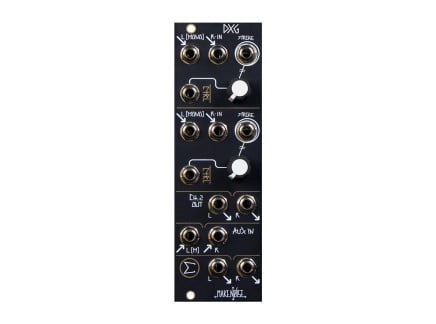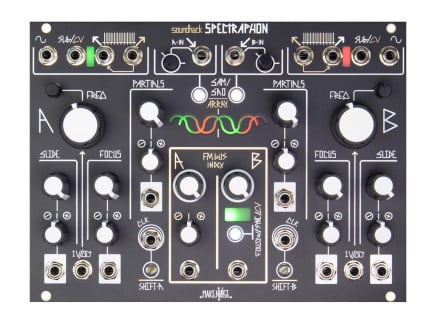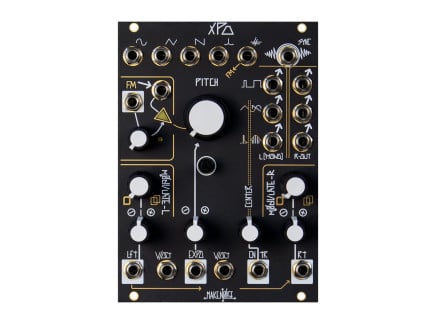In one of the first truly exciting new Eurorack developments of 2024, Make Noise has introduced their newest module: DXG, a dual low pass gate (LPG). You might think, "Hey, Make Noise has made an awful lot of dual low pass gates—so what makes this one so different?" Well, that's an excellent question, and the answer can be boiled down to two main points:
- DXG is stereo—that is, it contains two stereo low pass gates.
- DXG does not use vactrols—making its response much more predictable and controllable (more thoughts on that to come).
For all of you LPG fanatics out there, this should stand out as being a significant development. It's notoriously difficult to match the response of traditionally-constructed LPGs, making predictable stereo operation quite difficult. Moreover, one of the most critical components of the traditional LPG—an optoisolator commonly referred to as a "vactrol"—has become increasingly difficult and increasingly expensive to source over the years, leading many instrument designers to seek new ways to design LPG circuits.
For those who aren't yet LPG fanatics, you might have a different set of questions. What the heck even is a low pass gate? Why is it such a big deal, and why do modular synth people seem to talk about them so much? Worry not—I've answered many of these questions in our full article What is a Low Pass Gate?, which discusses the history of the concept as well as many of the barriers that lead to consistent mass production of these peculiar yet quite useful synthesis tools. Head to that article if you want to get deep into this topic; but, for those of you who want to cut to the chase, here's a recap.
What is a Low Pass Gate?
Low pass gates as we know them were originally created by the artist and electronic musical instrument designer Donald Buchla in the early 1970s; they were commercially introduced in his Series 200 Electric Music Box, a rare and now "cult classic" modular synthesizer system. Since the proliferation of Eurorack modular synthesizers in the 21st century, LPGs have become considerably more common, and today, they're a staple part of many distinct instruments from many manufacturers.
A low pass gate is used similarly to how one might use a low pass filter or a VCA in a more conventional synthesizer; however, it couples the amplitude and filtering response. As an LPG opens, it gets simultaneous brighter and louder; as it closes, it gets quieter and darker in tandem. This is particularly useful for creating decay characteristics similar to acoustic instruments such as mallet percussion or plucked strings. These characteristics of an LPG are sometimes also used for simulating the sonic behavior of sounds traveling great distances, helping to establish a sense of foreground/background without the need for a more conventional reverb. The filtering effect of an LPG is usually quite gentle (often -6dB per octave), making it a fairly natural-sounding way to tame the high end of harmonically-rich signals.
The other "thing" about a traditional low pass gate is that its response is usually quite sluggish. That is to say, if you provide a traditional LPG a very short envelope, it tends to close slowly, imparting a pleasant "ring" onto the sound. Many describe this as sounding "organic." It is common to "ping" or "strike" an LPG using a short impulse or trigger, relying on its natural decay characteristic to create short, percussive tones.
Those are the strong suits of an LPG: they're great for percussive sounds; they're great for bringing an organic feeling to sounds with high harmonic content; they're great for imparting a sense of dynamism and space onto your sounds. That in mind, let's look at what led to DXG, and then take a closer look at DXG itself.
An Overview of Make Noise's LPG Designs
Picking up on the trajectory of Buchla's work, Make Noise has produced some of the most notable and influential LPG modules ever developed. Their first such module was the now-famous and heavily coveted QMMG Quad Multi Mode Gate—a module which expanded the original LPG concept by adding a high pass filter mode and internal feedback for resonant filter tones. QMMG was a complex module, using no fewer than eight vactrols in its construction; and as such, as demand grew (and as vactrol supplies dwindled and prices increased), it became more and more difficult to produce units with consistent response.
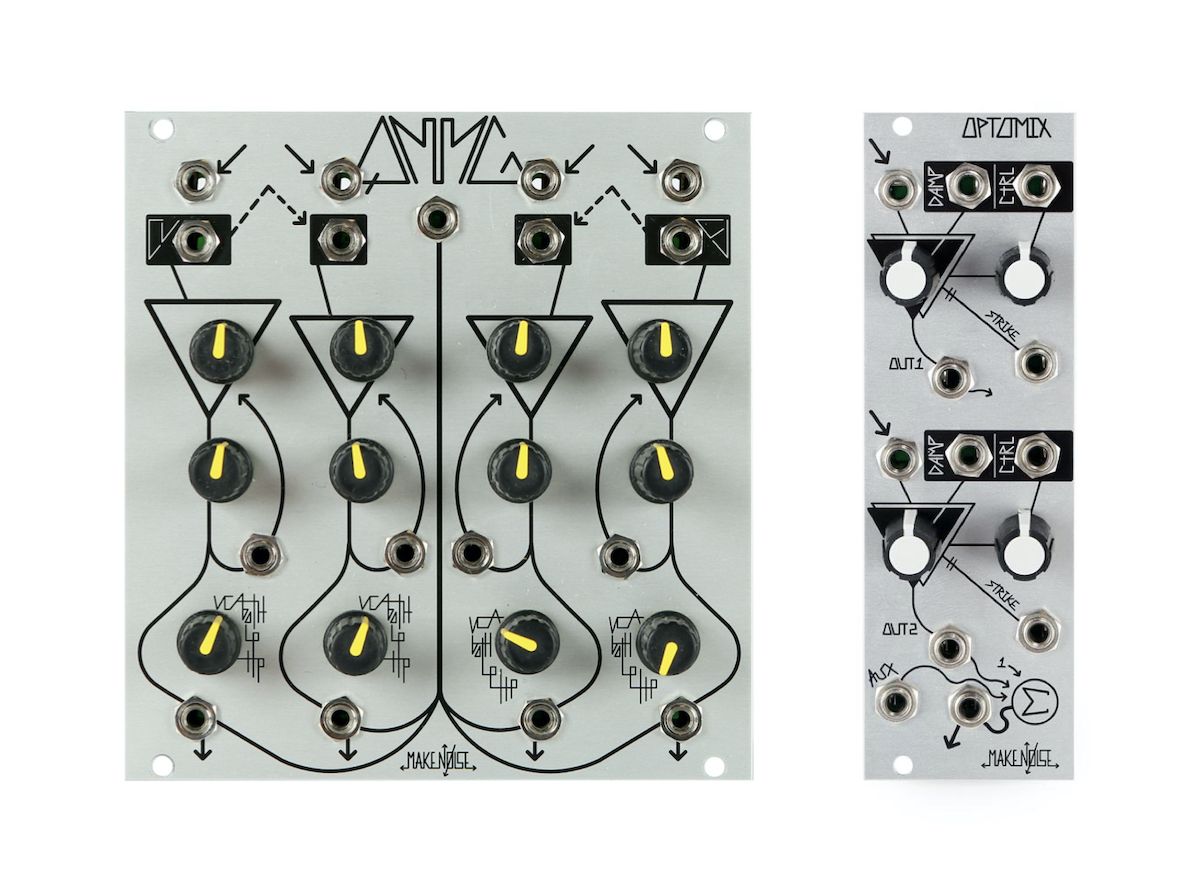
[Above: Make Noise's QMMG and Optomix side by side.]
Following the QMMG, Make Noise introduced the Optomix, a dual-channel LPG (which later became a core part of their Shared System and other instruments). Optomix offers a slightly different feature set than QMMG; it loses the mode selection option, and always operates in the "combo" lowpass/gate mode. It gains a "damping" control, which alters the "tightness" with which it responds to external CV (and gradually fades toward a seemingly less filtered, more transparent sound). It also features the first instance of Make Noise's now famous "Strike" input—an input designed to receive triggers or gate, which in turn "strikes" the vactrol used in the LPG circuit...creating that famous wood-like percussive LPG sound without the need for an envelope generator. Of course, the Ctrl input (and associated offset/attenuator) can also be used to open the gate when percussive sounds aren't what you're going for. Finally, Optomix can act as a simple mono mixer: it features a sum output which produces a mix of the two LPG channels and a third auxiliary input, allowing use as part of a "distributed mixing" system.
The QMMG and Optomix laid the groundwork for several subsequent modules, including the LxD Low Strike Duo, the MMG Multi Mode Gate, and, to an extent, the RxMx—a scanning mixer developed in collaboration with instrument designer Grant Richter. Some of Make Noise's most interesting and relevant developments in the last ten years, though, came in the form of the 0-Coast and the later Dynamix.
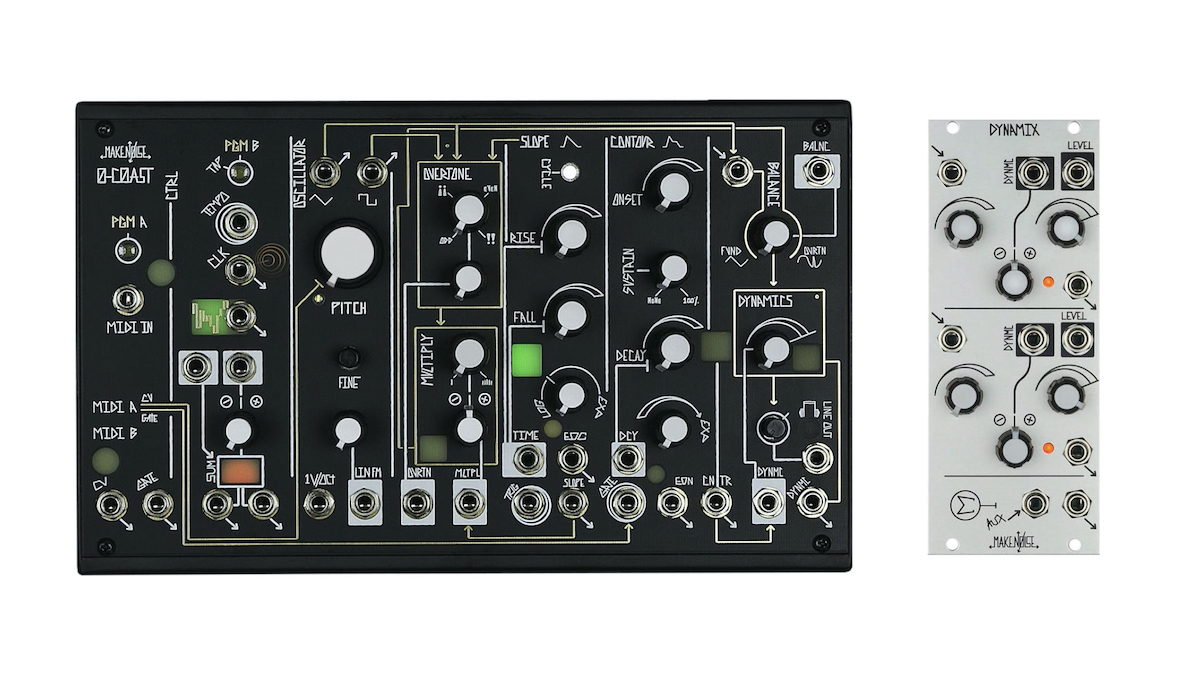
Above: the Make Noise 0-Coast and Dynamix side by side.]
The 0-Coast's "Dynamics" circuit brought a new approach the construction and functionality of LPGs. The Dynamics circuit is a novel design, implemented without the use of vactrols. As such, its behavior is much more consistent from unit to unit than vactrol-based designs, and it responds much more quickly to incoming CV (even operating gracefully when modulated at audio rates). It maintained the characteristic organic coupling of alterations to timbre and amplitude, but because of its improved response to faster control signals, it opened up completely new sonic opportunities. The Dynamix module offered a dual-channel version of this circuit designed to facilitate mixing, compression and more; however, its production was short-lived.
In the years since, increasing global regulations on the production and importing of vactrols (which contain small amounts of cadmium) have made it more and more difficult to consistently and affordably procure the parts needed to design a traditional LPG circuit. The 0-Coast and Dynamix foreshadowed the development of many new tactics for "working around" LPGs' dependence on vactrols; and today, many modular synthesizer companies have developed their own techniques for creating LPGs in a post-vactrol world.
DXG is the latest development in this ongoing saga.
The New Make Noise DXG Dual Stereo Gate
The new DXG Dual Stereo Gate represents the culmination of many past Make Noise designs. It offers an identical footprint and similar feature set as Optomix; and, like 0-Coast and Dynamix, its internal circuitry doesn't utilize vactrols. However, DXG's gates are not simply two 0-Coast Dynamics circuits strapped together behind a new panel: DXG features a completely new circuit whose design is tailored meet or exceed expectations of how a low pass gate should sound and behave. The result is (pardon the pun) quite striking.
DXG's design is fully analog, and fine-tuned specifically to emulate the slow decay characteristics of vactrol-based LPGs. Where 0-Coast and Dynamix offer a crisp new take on the LPG sound, DXG instead aims to recreate the vactrol-based LPG experience: and it does so in stereo. The refined design means that both stereo channels are accurately matched, ensuring consistent response across your stereo image. Given the increasing focus on stereo sound generation and processing in Make Noise's lineup (and Eurorack in general), this is a very welcome development.
DXG's footprint, layout, and feature set are quite similar to its predecessor Optomix—though it abandons the per-channel Damping controls to make room for each channel's stereo I/O. Each of its two channels offers left and right audio inputs, which are normalled together for use with mono signals. The per-channel CTRL parameter, as on Optomix, can be used to open the gate either manually or under voltage control; when used with external CV, the CTRL knob acts as an attenuator for the incoming CV signal. Each channel maintains the familiar "Strike" input as well, ensuring many more years of percussive plonks and bongos ahead (nice). Interestingly, the Strike input is sensitive to the voltage level of incoming triggers—allowing use as a dynamic control. This makes a great pairing with, say, the 0-CTRL, which features a dynamic gate output...but of course, you could always use a VCA before the Strike input to dynamically modulate the amplitude of any gate source. This is a peculiar and incredibly useful feature—one which we suspect will lead to interesting new ways of thinking about dynamic patching altogether.
It's also worth noting that DXG's decay time is "adaptive," in a sense: it adjusts based on the frequency of the incoming control voltage. So, with lower-frequency signals, you'll get a classic vactrol-like LPG response; with faster (and even audio-rate) signals, though, the response gets faster. This makes DXG a fine choice for amplitude modulation-like techniques which are often difficult to achieve with more sluggish LPG responses. This is yet another interesting and relatively unique feature, which will no doubt push DXG into territory that most prior LPG designs can't approach.
So, DXG will work splendidly alongside your XPO, Morphagene, or other stereo sound sources—imparting uniform dynamic and timbral shaping on both channels. However, it is also intended to act as part of your Eurorack system's stereo mixing workflow. The bottom of the module features left and right sum outputs, as well as an auxiliary stereo input. This can be useful for chaining together multiple DXGs, or for sending the output of any other stereo module (say, an X-Pan or Erbe-Verb?) straight through to the stereo sum output alongside both LPG channels.
DXG's refined and concise feature set will make it a quite appealing choice for any Eurorack system; and of course, it will make an excellent pairing to any system that strongly features the XPO Stereo Prismatic Oscillator, Morphagene, or the Spectraphon—some of Make Noise's most stunning stereo (or otherwise multi-channel) sound sources. Additionally, in combination with an X-Pan mixer and/or XOH output module, it makes for a surprisingly flexible and open-ended end-of-chain mixing solution. So, if you're looking to add the lively response of an LPG to your Eurorack system's stereo sound sources or mixing workflow, I know exactly what I would recommend.

